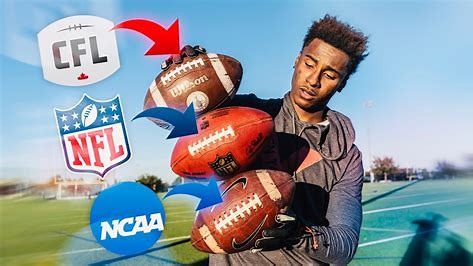
Imago
Image via Barkmanoil

Imago
Image via Barkmanoil
With football, the size of the ball might seem like a minor detail. But ask any quarterback, and they’ll tell you: it’s not just the plays that matter—it’s the grip. It’s how it feels in your hands. A little heavier, a little lighter, and your completion rate can drop drastically. Ask the Indianapolis Colts in the NFL. They’re still complaining about the Delfategate. Then, we always see the curious case of kickers. Justin Tucker is always asking for a ball change. Naturally, there can be a noticeable difference in the balls within the same game.
Watch What’s Trending Now!
Now, stretch it to the league. And then across different levels of football. Before the athletes hit the pros, they earn their right to be included in an NFL roster by doing the hard years in high school and college football. What’s the situation with balls at those levels of the game? Let’s take you through it.
ADVERTISEMENT
High School Football vs. College Football: A game of inches and ounces

ADVERTISEMENT
Let’s break it down. High school footballs are a smidge larger than youth versions but not as hefty as college-level ones. They measure 21 to 22 inches in circumference and tip the scales at a minimum of 14 ounces. Air pressure? It’s got to hit that sweet spot of up to 12.5 psi. This balance ensures young players can grip and control the ball without sacrificing safety or performance. Now, when players step onto a college field, it’s like graduating to a bigger playground. College footballs are slightly sleeker, with a circumference of 20.75 to 21.25 inches and weighing 14 to 15 ounces. While the weight difference might sound trivial, it’s like the difference between throwing a tennis ball versus a baseball—precision changes everything.
Why the difference, you ask? It’s about skill evolution. High school players are still mastering fundamentals, so the ball’s size helps with grip and accuracy. College athletes, meanwhile, face elite defenses and need a ball that enhances distance and aerodynamics. It’s a subtle upgrade that ensures the game develops with the player.
ADVERTISEMENT
So, next time you watch a high school or college game, take a moment to appreciate the ball. It’s not just a piece of leather—it’s tailored for every throw, kick, and catch. After all, the weight of the game depends on the size and weight of the ball!
Top Stories
Josh Allen Makes Lifetime Buffalo Announcement as Pregnant Hailee Steinfeld Receives Bills QB’s Clear Family Plan

NTSB Appeals for Greg Biffle’s Wife’s Alleged In-Flight Text Messages as Crash Investigation Heats Up

Travis Kelce Reveals Real Reason Behind Decision to Snub the Media Amid Retirement Rumors

Sean Strickland Passes on UFC White House Opportunity in Yet Another Bold Confession

Donald Trump Issues Moving Message of Condolence for NASCAR’s Greg Biffle & Family During North Carolina Address

Another Almost Fatal Disaster Surfaces From Statesville Airport Amidst Ongoing Greg Biffle’s Crash Investigation

So, why are football sizes important?
Football size matters because it’s all about setting players up for success. Picture giving a little kid a ball the size of a watermelon—it’s not going to end well! The ball needs to fit comfortably in their hands so they can grip, toss, and handle it with ease. The right size builds confidence and keeps frustration at bay. When players feel in control, they’re more likely to stick with the game and sharpen their skills. The right ball?
ADVERTISEMENT
So, we can conclude that the difference between this size football and professional footballs is very small, with a professional football being a little larger. The 9th to 12th grade and college students can easily transition from high school football to the NFL and other professional leagues, thanks to similar ball sizes. The balls go up in size from peewee to professional, allowing you to find a football that will always fit your and your child’s hands!
ADVERTISEMENT
ADVERTISEMENT
ADVERTISEMENT

